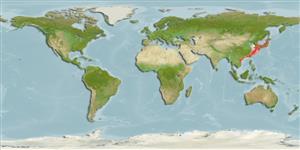>
Eupercaria/misc (Various families in series Eupercaria) >
Callanthiidae (Splendid perches)
Etymology: Callanthias: Greek, kalos, kallos = beautiful + Greek, anthias = a fish (Sparus aurata) (Ref. 45335).
Environment: milieu / climate zone / depth range / distribution range
Ecologia
marino benthopelagico; distribuzione batimetrica 70 - 200 m (Ref. 11230). Temperate
Northwest Pacific: southern Japan and East China Sea.
Size / Peso / Age
Maturity: Lm ? range ? - ? cm
Max length : 23.3 cm SL maschio/sesso non determinato; (Ref. 110004)
Short description
Chiavi di identificazione | Morfologia | Morfometria
Spine dorsali (totale) : 10; Raggi dorsali molli (totale) : 11 - 12; Spine anali: 3; Raggi anali molli: 10 - 11. Body color pink, ventrally yellow. Body elongate, compressed. Snout short, evenly rounded. Preoperculum rounded and smooth. Operculum with 2 spines. Attains 20 cm SL.
Occurs in sandy gravel or rock bottom (Ref. 11230).
Life cycle and mating behavior
Maturities | Riproduzione | Spawnings | Egg(s) | Fecundities | Larve
Masuda, H. and G.R. Allen, 1993. Meeresfische der Welt - Groß-Indopazifische Region. Tetra Verlag, Herrenteich, Melle. 528 p. (Ref. 9137)
IUCN Red List Status (Ref. 130435)
Threat to humans
Harmless
Human uses
Pesca: commerciale
Strumenti
Special reports
Download XML
Fonti Internet
Estimates based on models
Preferred temperature (Ref.
123201): 11.1 - 21.2, mean 18.4 °C (based on 109 cells).
Phylogenetic diversity index (Ref.
82804): PD
50 = 0.5039 [Uniqueness, from 0.5 = low to 2.0 = high].
Bayesian length-weight: a=0.00977 (0.00387 - 0.02465), b=3.08 (2.86 - 3.30), in cm total length, based on LWR estimates for this (Sub)family-body shape (Ref.
93245).
Trophic level (Ref.
69278): 3.4 ±0.45 se; based on food items.
Fishing Vulnerability (Ref.
59153): Low vulnerability (18 of 100).
